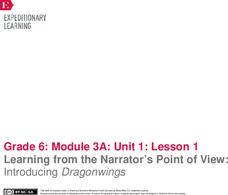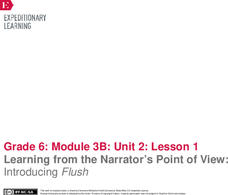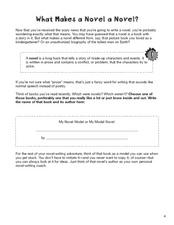Curated OER
Hawthorne: Author and Narrator
Students examine the difference between a narrator and author. They read Nathaniel Hawthorne's novel, 'The Scarlet Letter,' write a description of the narrator, and research how Hawthorne was impacted by the politics of the time.
K12 Reader
Narrator’s Point of View Flow Chart
How can you tell what point of view a narrator is using, and why does it matter when reading or writing? Use a handy flow chart to determine whether or not your narrator is telling the story from a first or third person point of view.
Curated OER
Author's Purpose
Sixth graders brainstorm the reasons authors write, and they list their responses on the board. Students discuss each purpose they have listed.Students work independently to read the selection "Tarantulas and Typhoid" by...
Curated OER
Author's Day
Have your learners choose an author to study. One resource link gives a list of approved authors. Scholars read at least three works produced by that author and produce three separate book reports as well as a two-page author report....
K12 Reader
Narrator and Point of View
Point of view is important when choosing a narrator. Help young writers distinguish between first and third person point of view with an activity that features excerpts from Robert Louis Stevenson's Treasure Island. After reading...
EngageNY
Learning from the Narrator’s Point of View: Introducing Dragonwings
Journey into the past with Laurence Yep's Dragonwings. Scholars complete anchor charts to analyze techniques the author uses to develop the narrator's point of view in his novel. As they read, pupils also complete word catchers to...
EngageNY
Learning from the Narrator’s Point of View: Introducing Flush
It is all down the drain. Scholars read chapter one of Flush and write any unfamiliar words in their word catchers and identify the narrator and point of view of the story. Pupils complete a point of view anchor chart and use Thought,...
Curated OER
What Makes a Novel a Novel?
As your authors prepare to write a hypothetical novel, they need all the inspiration they can find! Using a book they have already read (and enjoyed), learners complete a literary analysis by filling in eight short-answer...
Curated OER
Comparing Poems
Young literary analysts compare two poems by the same author. Readers look for slant rhyme, observe the beat and rhythm of each, and search for repeated vowel sounds. After re-reading, they observe the lack of punctuation and the stanza...
Curated OER
Summer of the Monkeys
While reading the book Summer of the Monkeys by Wilson Rawls, the class ties together the core reading objectives, which are making predictions, comprehending new information, reading for author's purpose, independence in reading,...
Curated OER
Express Yourself Lesson Seed 8: Character
Characters often change over the course of a story or novel. Use the sample graphic organizer provided here to track how the narrator has responded to the sequence of events in chapter four through six of The Cay. In addition to this...
Curated OER
Frankenstein
Share a classic novel with your class using this resource. After reading Frankenstein by Mary Shelley, learners answer questions involving the narrator's point of view, make and confirm predictions, and sequence events in the story.
Curated OER
Hawthorne: Author and Narrator
Students read various pieces of literature by Nathaniel Hawthorne to recognize the difference between a narrator and author. Students in small groups report on the narrative point of view represented in a story they have read.
Curated OER
The Call of the Wild
Students read The Call of the Wild, noting its theme of survival. They investigate the book's concepts with word webs, spider maps, or graphic organizers. They conduct a panel discussion on dogs and wolves. They write a letter to the...
Curated OER
Historical Agency in History Book Sets (HBS)
Study historical events by combining the study of historical fiction and non-fiction. Learners read about true past events in historical fiction novels and then research non-fiction accounts of the same events. What are some differences...
National Endowment for the Humanities
Literary Genres in “Moby-Dick”
Moby Dick is more than a whale of a tale narrated by Ishmael. A lesson studying Herman Melville's classic novel asks readers to examine the different genres the author weaves into his story. Instructors model how to conduct a stylistic...
Teachers.net
Point of View
Work with your class on point of view by reading "The Three Little Pigs." Learners demonstrate an understanding that the point of view is determined by the author and that different points of view exist. They then read a different short...
Planet e-Book
Dubliners
The Dubliners contains 15 short stories all bound in one book. The stories begin with narration by young children, and as they progress, so do the ages of the narrators. The author, James Joyce, focuses most stories on characters that...
Curated OER
Finding Problems In A Story
Students categorize information into a problem/solving chart and examine the value of using a diary. In this problem solving and diary lesson, students read portions of Dear Mr. Henshaw, while they investigate the importance of keeping a...
Syracuse City School District
Literary Elements
Address the literary elements in a piece of writing using these materials. The packet includes plenty of resources, and focuses mainly on theme, character, and point of view, with some materials for setting, symbolism, and author's...
Curated OER
Edgar Allan Poe's The Raven Part 1
Quoth the raven - nevermore! Delve into Edgar Allan Poe's' The Raven," but not too deeply. Answer reading comprehension questions in this multiple-choice quiz without getting too much into the mind of the narrator or poet himself.
Santa Ana Unified School District
Characters
Are your learners only talking about the plot of the story and not the richness of the characters? Then show them how important characters are to literature with the information available here. The learner will know how authors create...
Curated OER
Direct and Indirect Characterization
How does an author develop his or her characters? Using the short story "On the Bridge" by Todd Strasser, readers study character development by looking for examples of both direct and indirect characterization. They plot these points on...
Curated OER
"The Chase" Reading Questions
"The Chase," a chapter from Annie Dillard's autobiography, details an iceball project the narrator and her friends used to play. After your class reads the chapter, give them this reading assessment. Provided here are five short-answer...

























